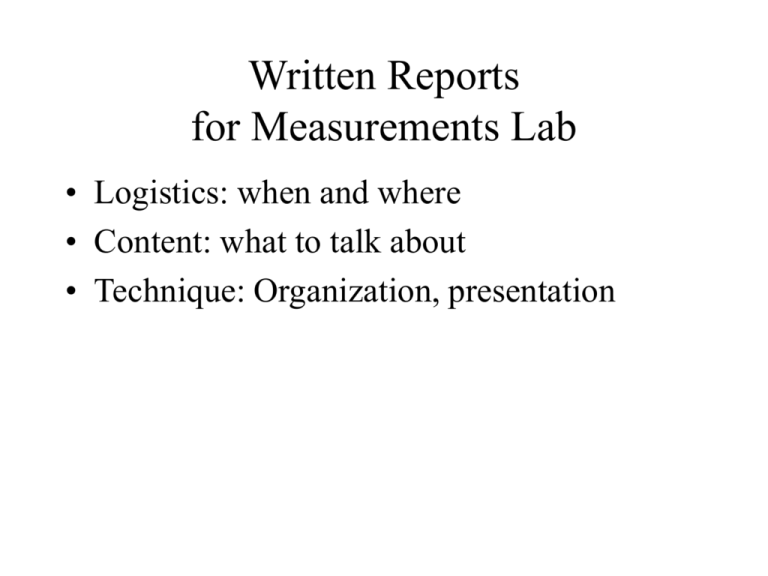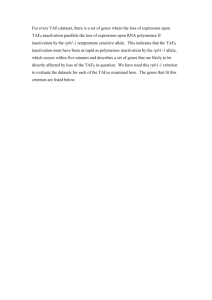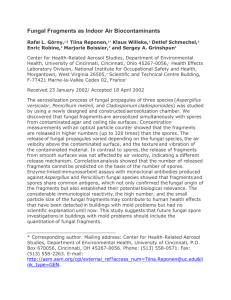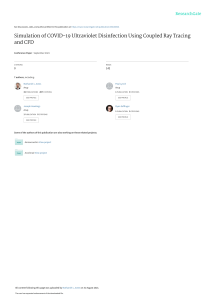power point presentation on the written reports
advertisement

Written Reports for Measurements Lab • Logistics: when and where • Content: what to talk about • Technique: Organization, presentation Logistics • When: See schedule • What you will turn in: • One report per group • Turn in answers to questions • please NO plagiarism either from other students or books… • How long? • Around 15 pages of double spaced text • Appendices extra Presentation Content Beginning: tell about the problem and why your experiment is an important one - provide context Middle: describe how you did your experiments and what was found End: summarize it all, tell what it means, did you meet goals, what are your recommendations for future work in this area? Report Components • • • • • • • • Title Abstract Introduction Experimental and/or Theoretical Methods Results and Discussion Summary and Conclusions References Appendices Structure of Report Start with broad knowledge base Abstract Intro Narrow to focus of report Results Discussion Broaden again, relate back to beginning Conclusions Title • Title should be concise, complete, comprehensible, correct, descriptive (and not the title of the lab procedures) • Title should have the following: title, authors, affiliation, date • Does not have to be on a separate page, see sample journal articles Examples • Pulse, Echos, and Goo” • “The Applicability of Ultrasound in Determining Mechanical Properties of Materials” – Which one is good or bad? • “A Comparison of Extended Surfaces” • “Enhancing Convective Heat Transfer using triangular and cylindrical Extended Surfaces” – Which one is good or bad? Example Title for your paper Environmental Tobacco Smoke Particles in Multizone Indoor Environments Shelly L. Miller and William W. Nazaroff Department of Civil and Environmental Engineering University of California, Berkeley, California USA Paper submitted to Atmospheric Environment October 27, 2000 Abstract • Abstract is a miniature version of the report. • It should stand alone. • Structure ~200 words (use “word count” in MS WORD to make sure that your abstract is not too long!) • What was done • How is was done • The principal results • The significance of the results • Quantitative with uncertainties Heat Transfer and Pressure Drop Characteristics of Laminar Flow in Rectangular and Square Plain Ducts and Ducts With Twisted-Tape Inserts S.K. Saha and N. Mallick The present paper reports the results of an experimental investigation of the heat transfer and pressure drop characteristics of laminar flow of viscous oil through horizontal rectangular and square plain ducts and ducts inserted with full-length twisted tapes, short-length twisted tapes, and regularly spaced twisted-tape elements. Isothermal pressure drop measurements were taken in acrylic ducts. Heat transfer measurements were taken in electrically heated stainless-steel ducts imposing uniform wall heat flux boundary conditions. The duct aspect ratios AR were 1, 0.5, and 0.333. The twist ratios of the twisted tapes were y=2.692, 5.385, 2.597, 5.193, 2.308, and 4.615. Short-length tapes were 0.9, 0.7, and 0.5 times the duct length. The space ratios were s=2.692, 5.385, 2.597, 5.193, 2.308, and 4.615. Both friction factor and Nusselt number increase by 30% (+ 5%) with decreasing y and AR for AR1 and increasing Re, Sw, and Pr. As the tape-length decreases by a factor of 2, both friction factor and Nusselt number decrease by a factor of 3. Friction factor increases by 80% (+ 12%) as s decreases by 50%, and Nusselt number increases by 75% (+ 30%) as s increases by 100%. Isothermal friction factor correlation and comprehensive Nusselt number correlation have been developed to predict data reasonably well in the entire range of parameters. Performance evaluation says that short-length twisted tapes are worse and regularly spaced twisted-tape elements are better than the full-length twisted tapes. What How Results Significance This is about 200 words Introduction • Purpose - What you did and why you did it – Clearly state goals – May include a review of scientific literature to justify the what and why, and to define the • Scope - Range, how much, limits of applicability of what you have done • Background - What the reader needs to know to understand what comes – Fundamental ideas involved. • Make sure you answer these questions: – What has been done on this problem before? – What’s the point of the report? – What was your contribution? Example of objective paragraph in introduction As a pilot study, we measured the CO, NO2, and PAH emissions from the operation of unvented natural gas fireplaces existing in two homes in Boulder, Colorado. Pollutant concentrations were monitored under various operating conditions in the room where the fireplace was located. In this paper, we present the theoretical framework used to evaluate our experimental results followed by a description of the experimental methods and monitoring locations. Finally, we present and discuss these preliminary results, with particular emphasis on potential human health impacts involved with the use of unvented natural gas fireplaces. Experimental/Theoretical Description • How did you do what you did? What equipment and/or theory was used? • Describe the procedures followed, not a detailed list (like in the lab manuals), but just enough so that the reader can follow you • For modeling include major mathematical expressions as part of a description of your methods. Number your equations • For experiments point out major pieces of equipment and provide a schematic of the experimental layout. Make sure to list equipment with who made the equipment and the model number. For example, if you used an oscilloscope, then list it as model DS03152A, Agilent Technologies Example of Theoretical Description for a Modeling Study LIF diagnostics have been constructed by pumping from the X-state to both the A and B-states, although pumping to the A-state (the so-called bands) is preferable due to the longer excitation wavelengths required. This reduces problems with attenuation of laser light and LIF signals and complex electronic energy transfer. In modeling the excitation process one solves a set of time dependent rate equations, one for the population Ni of each quantum state i considered. The equations take on the generalized form dN i Q ji W ji N j Qij Wij N i Qlost N i dt j i j i (1) Here, the first term represents the rate at which collisions (Qji) and radiative transitions (Wji) populate state i, the second term the rate at which state i is depopulated by collisions and radiative transitions, and the final term (Qlost) the sum of all process that depopulate… Example of Methods for an Experimental Study Intrinsic Inactivation Rate of Airborne Fungal Spores to Ultraviolet Germicidal Irraqdiation (UVGI). Experiments were conducted in the pilot-scale chamber to estimate the intrinsic inactivation rate of airborne fungal spores to UVGI. After purging the chamber with clean air, airborne fungal spores were continuously generated (for usually 15 minutes) to raise the concentration in the chamber to a suitable level for detection. Two box fans (48-cm diameter, Model 3723, Lasko Inc., West Chester, PA) were turned on to ensure mixing. No ventilation was provided during this period and the UVGI lamps were kept off. Once the fungal spore aerosolization was stopped, sampling of the airborne fungal spores was initiated. Also in some of the experiments, UVGI lamps were turned on at this time. Samples were collected 4 or 5 separate times with duplicate liquid impingers as the concentration decayed over a 14 or 26 min period. For each sample, the impingers were operated for 3 to 5 minutes. The shorter decay time (14 min) was used for experiments in which UVGI lamps were operating, while the longer decay time (26 min) was used for tests with UVGI lamps not in operation. After the final sample was collected, the chamber was purged again with the clean air. Decay experiments were conducted without the UVGI system operating to measure removal of airborne fungal spores by deposition, exfiltration, and natural die-off. No ventilation was provided during these experiments. A completely-mixed room model was used to estimate the inactivation rate of UVGI as previously described (Miller-Leiden et al. 1996; Xu et al. 2003, Xu et al. 2005). In summary, the least-squares method was used to fit lines to the log-transformed concentrations measured over the decay period, and inactivation rates were inferred by subtracting the slope of the lines for the no-UVGI experiments from those with UVGI. The UVGI inactivation rate has units of ACH or h-1. Example Schematic North Wall East Wall Exhaust Air (Ceiling) Supply Ai r (Ceiling) * Biosafety Ho od Nebulizer Air cyli nder Door Source, 1.1 m M. parafortuitum and B. subtilis samplers Locations 2.1 m 1.5 m Radiometer, 2.1 m 0.3 m Corner Wall-Mount ed UV Lamp Mixi ng Fan * Center Pendant UV Lamp M. bovis BCG samplers at 1.5 m Figure 1. Schematic (top view) of test chamber. Figure 1 Remember • Functional drawings only, not pictures • label everything in the drawing Results and Discussion • First present your results, including your estimates of uncertainty • Then discuss the significance of the results. Do they prove your hypothesis, match a theory, etc. • Be careful not to mix the two. In other words, do not manipulate the way you present your results just to support a preconceived idea Uncertainty Analysis • When a measurement is mentioned, include its uncertainty • Include your uncertainty analysis in an appendix • Describe the details of how you estimated uncertainty • “We took repeated measurements, then used the SD and student’s t-distribution to obtain the 95% CI.” • “The mean acceleration was 10 m2/s ± 2.1 m2/s @ 95%.” • “There was error from measuring the volume of water. The increments on the sight glass were 1 L. Thus, we estimated the uncertainty in V to be 0.5 L.” Tables • Tables need titles! Half or full-page tables/graphs usually work the best. Remember to refer to table in your text. Table 1 Airflow rates measured du ring t wo-room ETS particle expe rimen ts (m 3 h-1)1 ACH FO,N Ff,S Ff,N (h-1)2 0.001 1.6 0.2 0.8 0.2 Ğ Ğ 0.04 2.5 0.03 4.2 0.1 3.1 0.04 3.7 0.1 Ğ Ğ 0.1 FN,S FS,N FS,O Baseli ne 60 4 59 4 2.4 1.7 Segregation Exh aust ven til ation 1 FO,S Scenar io 0.6 0.03 1.1 0.01 FN,O 0.001 92 2.4 17 0.8 107 1.7 0.0 0.0 32 1.8 75 1.4 Ğ Ğ 1.7 Enh anced ven til ation 154 17 163 17 11 5 19 1.4 2 1.3 Ğ Ğ 0.3 N fil tration 128 4 128 4 10 5 0.004 0.004 2.7 1.9 0.3 0.2 2.4 0.2 Ğ 91 9 0.03 S filt ration 46 0.9 47 0.8 0.0 0.0 2.4 0.8 0.7 0.1 1.6 0.1 91 9 Ğ 0.03 The air flow rates were e s timated fro m tracerga s measurements us ing a non li nearl eas t-squares minimi zation technique (Mill er et al., 1997). Refer to Figu re 2 for airflow rate no menclature . 2 The se air exchang e rates , exp res sed i nun its of air -ch ange s per hour (ACH), represent the amount of air exchanged w it h the outdoor s forth e sys tem acting as a s ingl e zone . Example Figure Tables need Captions, always underneath figure and numbered! Remember to refer to Figure in your text. 140 120 Medium Flame 100 CO (ppm) • 80 Flame Extinguished Manually 60 High Flame 40 Flame Extinguished Automatically 20 Low Flame 0 0 120 240 360 480 600 720 840 960 elapsed time (min) Figure 1. Typical CO profiles measured during the operation of unvented Fireplace A at the low, medium and high heat settings during (a) Spring 1997 and (b) Spring 1999. Vertical lines indicate the instant when the flame was reduced or extinguished, either manually at the completion of the test or automatically during the test by the oxygen depletion sensor. The CO monitor's maximum detection limit of 128 ppm was surpassed during the 1999 tests. Example Figure Must have a Title and Figure Number and reference This figure number in Your text! Figure 1. a) Full length twisted-tape insert inside a duct and b) regularly twisted tape elements. Summary and Conclusions • Start with a restatement of objectives • Again describe briefly the methods • State the important results: be quantitative with uncertainty • State the important conclusions • Comment on what should be done in future experiments, what would you recommend doing next? References • When you use an idea from a book, or paper, or website, you need to “cite” that idea. • Please use the “name and year “ system when citing in your text. • Then in the list of references, provide details about the reference. • You must have 3 references, only 1 from a website. The others can be from your textbooks, books at the library, journal paper (can download from web or get at library). • No citations from Wikepedia Example Introduction In the early 1990s, many epidemiologic studies suggested that air pollution, even at the lower ambient air concentrations that had been achieved with regulations and control technology, was still associated with cardiopulmonary disease and mortality (Samet et al., 2000); especially the fine combustionsource pollution most commonly found near heavy traffic areas (Pope, 2000). … References Samet, J. M., F. Dominici, F. C. Curriero, I. Coursac, and S. L. Zeger (2000). Fine Particulate Air Pollution and Mortality in 20 Us Cities, 1987-1994, New England Journal Of Medicine. 343:17421749. Pope, C. A. (2000). Review: Epidemiological Basis for Particulate Air Pollution Health Standards, Aerosol Science And Technology. 32:4-14.






